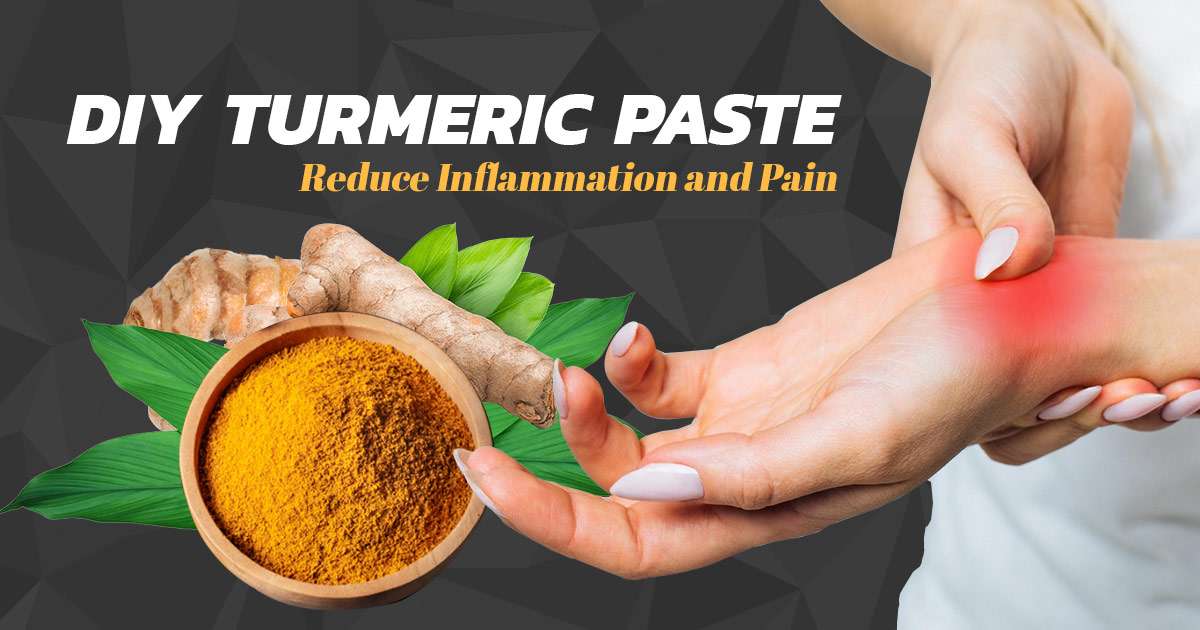DIY Turmeric Paste: Naturally Reduce Inflammation and Pain

Making your own turmeric paste at home can be a simple and effective way to naturally reduce inflammation and pain. Turmeric is a bright yellow spice often used in cooking, particularly in Indian dishes. Its main active ingredient, curcumin, has powerful anti-inflammatory and antioxidant properties. Turmeric has been used in traditional medicine for centuries to treat various health issues. Nowadays, it is valued not only for cooking but also for its health benefits.
Curcumin makes up about 3% of turmeric by weight, but it’s incredibly potent. To help your body absorb it better, turmeric is often mixed with black pepper, which has piperine. This blend can increase curcumin absorption significantly. Including turmeric in your diet or as a topical treatment can provide numerous health benefits, particularly in reducing inflammation and pain.
How Can Turmeric Help with Rheumatism Pain?
Turmeric can help ease rheumatism pain because it has strong anti-inflammatory properties. Rheumatism includes conditions like rheumatoid arthritis and osteoarthritis, which cause joint pain, stiffness, and inflammation. Curcumin, the active ingredient in turmeric, targets different pathways that cause inflammation, helping to reduce symptoms of rheumatism.
Studies show that curcumin may block the activity of inflammatory enzymes and proteins involved in joint inflammation. This can help manage pain and improve joint function for people with rheumatism. Additionally, turmeric’s antioxidant properties can neutralize free radicals that cause joint damage and inflammation over time. Adding turmeric to your diet or using turmeric paste on your skin may provide natural relief for rheumatism symptoms, complementing other treatments recommended by healthcare professionals.
How To Make Activated Turmeric Paste
Making turmeric paste at home is simple and cost-effective. Follow these steps to create your own activated turmeric paste:
- Ingredients:
- 1/2 cup of turmeric powder
- 1 cup of water
- 1/2 teaspoon of ground black pepper
- 1/4 cup of coconut oil or olive oil
- Instructions:
- In a small saucepan, mix turmeric powder and water over low heat.
- Keep stirring until it becomes a thick paste, which usually takes about 7-10 minutes.
- Mix in the ground black pepper and oil with the paste, stirring thoroughly to blend everything together.
- Allow the paste to cool before transferring it to a glass jar.
- Keep the paste in the fridge for as long as two weeks.
This paste can be used as a base for a homemade turmeric cream for pain or applied directly to areas where you experience inflammation.
How Do You Use Turmeric Paste?
Turmeric paste can be used in various ways to help with pain and inflammation:
- Topical Application: For topical use, put the paste directly on the skin where needed.
- Incorporate into Recipes: Add a teaspoon of the paste to smoothies, soups, or teas for an anti-inflammatory boost.
- Turmeric Milk: To make turmeric milk, stir a teaspoon of the paste into a cup of warm milk, whether it’s dairy or plant-based, for a calming beverage.
Why Turmeric Paste Is Very Effective
Turmeric paste is effective because it has a high concentration of curcumin, which targets inflammation at a molecular level. Curcumin blocks molecules like NF-kB that cause long-term swelling, making turmeric paste especially helpful for arthritis, joint pain, and other inflammatory issues.
Additionally, combining turmeric with black pepper significantly enhances curcumin’s bioavailability, making the paste more potent and effective. This improved absorption helps your body use curcumin more effectively.
Use Turmeric Paste Instead of Ibuprofen or Paracetamol
Many people rely on ibuprofen or paracetamol to manage pain, but these medications can have side effects, especially with long-term use. Turmeric paste provides a natural choice. Unlike artificial medications, turmeric has been safely used in traditional medicine for thousands of years.
Studies show that turmeric can help with pain relief. For instance, one study found that curcumin worked as well as ibuprofen in easing pain for people with knee osteoarthritis. Changing to turmeric paste helps you prevent possible adverse effects and less depend on over-the-counter painkillers.
Other DIY Alternatives to Turmeric Paste
If you’re looking for other natural remedies to reduce inflammation and pain, consider these DIY alternatives:
- Ginger Paste: Ginger has anti-inflammatory properties similar to turmeric. Make a paste using fresh ginger and water.
- Aloe Vera Gel: Aloe vera is famous for its calming effects. Apply the gel directly to inflamed areas.
- Epsom Salt Soak: Add Epsom salt to a warm bath. The magnesium in the salt can help relax muscles and reduce pain.
- Arnica Cream: Arnica is a natural treatment used to lessen bruising and swelling. You can find arnica cream in most health stores.
Conclusion: Embrace the Power of Turmeric Paste for Natural Pain Relief
Including turmeric paste in your everyday regimen could revolutionize your natural pain and inflammation control. The advantages are obvious whether your search is for a homemade turmeric cream for pain or turmeric paste for knee trouble. Natural and powerful alternative to traditional painkillers, turmeric paste boasts improved bioavailability and strong anti-inflammatory action. Give homemade turmeric paste a try today and see how it can improve your life.

